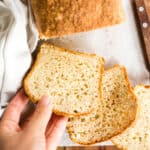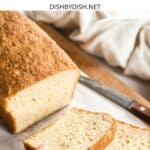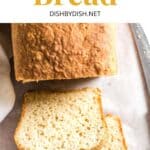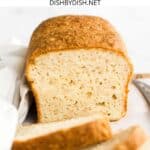Description
Tender, soft and incredibly fluffy, this delicious millet bread is perfect for making sandwiches, french toast, avocado toast, or simply toasted with jam. It’s totally gluten-free and dairy-free too, but nobody would care!
Ingredients
- 1 3/4 cup gluten-free all-purpose flour
- 1 teaspoon xanthan gum (leave this out if your GF flour blend already includes it)
- 1/2 cup millet flour
- 1/4 cup psyllium husk powder
- 1 teaspoon baking powder
- 2 1/4 teaspoons instant dry yeast
- 2 tablespoons sugar
- 1 teaspoon salt
- 1/3 cup sunflower oil
- 1 teaspoon apple cider vinegar
- 1 1/2 cups warm water (approx. 105 -110F)
- 2 large eggs, beaten (room temperature)
Instructions
- Grease and Preheat: Grease a 8″ x 4″ nonstick metal loaf pan and preheat the oven to 350F. Arrange the oven rack to the middle position.
- Combine Dry Ingredients: In a large mixing bowl, whisk the gluten-free all-purpose flour, xanthan gum (if using), millet flour, psyllium husk powder, baking powder, salt, instant yeast, and sugar together.
- Add Wet Ingredients: Add the oil, apple cider vinegar, warm water, and mix well until combined. Add the beaten eggs and mix for another minute until you get a dough that resembles thick cake batter (the dough will be sticky and wet, but that’s perfectly fine).
- Transfer Dough to Pan: Transfer the bread dough to the prepared loaf pan and use a wet spatula to smooth out the top of the dough.
- Let Dough Rise: Cover the pan with a kitchen towel and let the dough rise for the next 30 minutes in a warm, draft-free place until it has roughly doubled in size.
- Bake: Bake the dough for 50 to 60 minutes until the bread is golden brown on top and the loaf sounds hollow when tapped.
- Cool Completely: Allow the millet bread to cool for at least 10 minutes in the loaf pan, before removing it and cooling fully on a wire rack.
- Slice and Enjoy: Use a serrated bread knife to slice once the bread has fully cooled. Enjoy!
Notes
Gluten-Free All-Purpose Flour: I recommend using a good quality gluten-free flour blend that is made up of lighter flours/starch (such as rice flour, potato starch, corn starch or tapioca starch), to ensure a lighter final texture. I do NOT recommend gluten-free blends that include heavier flours (such as garbanzo bean flour) as that may result in a denser final texture.
Xanthan Gum: Xanthan gum acts as a substitute for gluten in gluten-free flours, and helps the ingredients to bind better together. If your gluten-free flour blend does not already include it, make sure to add it in.
Millet Flour: Since this is a millet bread recipe, millet flour is essential. You can either make your own homemade millet flour or buy it online. If you would like to make this bread with another type of whole grain flour such as buckwheat flour, brown rice flour, amaranth flour, sorghum flour, or quinoa flour, feel free to replace the millet flour in a 1:1 ratio of the flour you wish to replace it with.
Psyllium Husk Powder: In this recipe, the psyllium husk powder helps the ingredients to bind better together and allows it to dome properly. I do NOT recommend that you swap out the psyllium husk powder with any other ingredient.
Baking Powder: In addition to the yeast, baking powder helps the bread to rise a little more. If you are Celiac or gluten-intolerant, make sure you use certified gluten-free baking powder.
Instant Yeast: I like using instant dry yeast because there is no pre-activation period required.
Sugar: The sugar is required as food for the yeast to feed on so the yeast activates and produced the gases required to make the dough rise. Do not leave out the sugar – the bread will not taste sweet as the sugar will be consumed by the yeast.
Sunflower Oil: I like using sunflower oil because I always have a bottle of it on hand. However, feel free to use another vegetable oil such as olive oil, avocado oil, coconut oil if you prefer.
Apple Cider Vinegar: The apple cider vinegar (ACV) helps to create an acidic environment and reacts with the baking powder to help the bread dough rise more. If you don’t have ACV, you may also use white vinegar or wine vinegar in equal quantities.
Warm Water: Make sure the water is between 105F – 110F as the warmth is required to activate the yeast, but if the water is too hot, it will kill the yeast. I use water because it’s the easiest, but you can also use warm non-dairy milk such as almond milk or cashew milk if you want to add more flavor. If you are not lactose-intolerant, feel free to use normal milk instead.
Eggs: The eggs give the bread more rise and taste, and I personally haven’t tried making this bread without eggs. However, if you are allergic to eggs or want to keep this recipe totally vegan, feel free to substitute the eggs with aquafaba or an egg-replacer.
Storing/Freezing: To store, place the cooled millet bread in an airtight container and store in the refrigerator for up to 5 days. To freeze, wrap the cooled bread with a few layers of plastic wrap or place it in a freezer-safe container or ziplock bag and freeze for up to 3 months. Let the frozen loaf thaw completely overnight in the refrigerator before slicing. Alternatively, you can slice the bread beforehand and freeze it already sliced, so you can remove a slice at a time from the freezer and toast directly.
- Prep Time: 10 mins
- Rising Time: 30 mins
- Cook Time: 60 mins
- Category: Bread
- Method: Baking
- Cuisine: American



